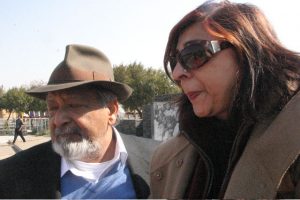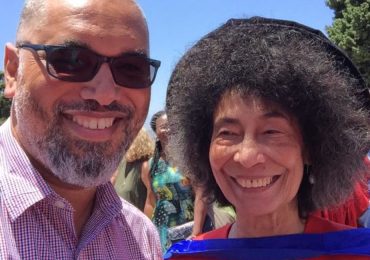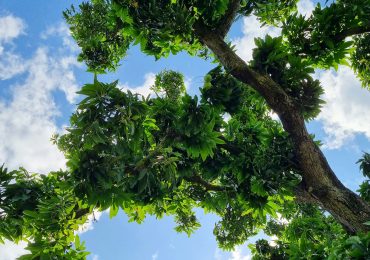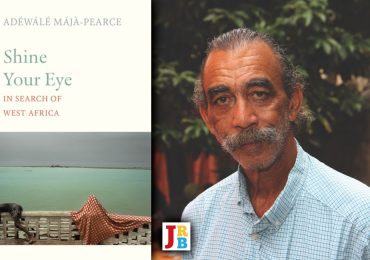VS Naipaul, who died aged eighty-five on Saturday, spent some months in South Africa in 2009, researching his final book. During his visit he and his wife, Nadira Naipaul, interviewed Winnie Madikizela-Mandela at her home in Soweto, resulting in a scandal of no small proportions.

Naipaul, who won the 1971 Booker Prize for his novel In a Free State, and whose long career in fiction and non-fiction earned him a knighthood in his adopted country in 1989 and the Nobel Prize in Literature in 2001, was known for his sharp, bleakly comic and exceptionally eloquent explorations of the legacy of colonialism. He also epitomised the question of whether an artist’s work can be separated from their character.
Born Vidiadhar Surajprasad Naipaul in 1932, to a family that had arrived in Trinidad from India in the eighteen-eighties as indentured labourers, Naipaul moved to England in 1950 to study at Oxford. After graduating he moved to London, where he worked for the BBC. His first novel, The Mystic Masseur, was awarded the John Llewellyn Rhys Prize in 1958, and shortly afterwards, in 1959, his collection of short stories Miguel Street won the Somerset Maugham Award, making Naipaul the first non-European to be selected for the prize.
Naipaul earned worldwide notoriety in 1961 with his critically acclaimed novel A House for Mr Biswas, a darkly comic masterpiece inspired by his father’s life. Following the novel’s completion, he spent time in British Guiana, Suriname, Martinique and Jamaica, making notes for what would be his first autobiographical travelogue, The Middle Passage: Impressions of Five Societies—British, French and Dutch in the West Indies and South America. In 1966, he was offered a writer-in-residence fellowship at Makerere University in Kampala, Uganda, where he wrote The Mimic Men. While living in Africa he travelled to Kenya and Tanzania, and drew on these experiences in his later novels In a Free State (1971) and A Bend in the River (1979), which are set in unnamed African countries.
In a way, Naipaul’s public writing life came to an end in Johannesburg; he visited in 2009 as research for his final book, The Masque of Africa: Glimpses of African Belief, which was published in 2010. The journey across Africa he documents in the book took him to Uganda, Nigeria, Ghana, the Ivory Coast Gabon and finally South Africa. He describes his conversations with Africans he meets along the way, in his search for the essence of the African belief systems that existed before the arrival of Christianity and Islam.
Naipaul’s visit to South Africa was ostensibly under the radar, but inevitably word got out and it caused quite a stir. In his quest to interact with ‘real’ South Africans, he insisted on visiting people in their homes, sometimes at short notice, accompanied by writer Khadija Bradlow, who acted as a guide, and his wife, Nadira. During his trip he interviewed the writer Fred Khumalo, documentary filmmaking couple Sipho Singiswa and Gillian Schutte, as well as Winnie Madikizela-Mandela.
Madikizela-Mandela was particularly outspoken and critical of Nelson Mandela during their discussion—a large part of which made it into The Masque of Africa. Naipaul found Madikizela-Mandela ‘still full of political passion, still close to the fears she felt in the bad times’, and he quotes her at length:
‘This is where it began, and I still live here. I cannot dream of leaving my people and going to live in a grand suburb.’
She was referring obliquely to the larger-than-life statue of Mandela that had been put up in a rich Johannesburg square. She thought it was a ‘foolish’ statue; and the day I went to see it two white children were playing on the chunky feet.
She said, ‘You must remember that the Mandela who went in’—went in: went to jail—’was a revolutionary, and the Mandela who came out was preaching peace and compromise. In fact, the statue should have been here in Soweto, where it all began and where he lived. The way to dilute a person is to commercialise him, and they have. The man who went to prison would not have allowed this commercialisation or being a brand name for a Foundation. My grandchildren are deeply hurt by all this commercialisation, and it is an albatross round their necks.’
A few months later, and a few months before the book was published in 2010, Nadira Naipaul penned a news article for the New Statesman that revealed Madikizela-Mandela’s harsh criticism of Mandela, causing outrage in South Africa. Madikizela-Mandela later denied giving the Naipauls an interview. The story made front page news around the country.
On his trip to South Africa, Naipaul visited the Voortrekker Monument, which he found singularly impressive, the Faraday and kwaMai Mai traditional medicine markets, which pained his vegetarian sensibilities, and the Hector Pieterson Memorial, where, according to Bradlow, he wept.
During his life, Naipaul was unashamedly candid about his prejudices and sometimes appalling behaviour. In 2008, for example, he openly informed his biographer, Patrick French, of his violence towards his former lover, Margaret Gooding. In 2011, in an interview at the Royal Geographic Society, he famously commented that he didn’t consider any woman writer his literary match, because of their ‘sentimentality, the narrow view of the world’, and insisted that he could tell if a writer was a woman ‘within a paragraph or two’.
He frequently expressed disdain for his native Trinidad and other ‘primitive’ societies. In a 1981 interview with Robert Boyers and Bharati Mukherjee for the literary magazine Salmagundi, Naipaul discounted his African readers, and the continent as a whole, saying, ‘I don’t count the African readership and I don’t think one should. Africa is a land of bush, again, not a very literary land.’ In the same year he told Michiko Kakutani Trinidadians did not read his books: ‘I can’t see a Monkey—you can use a capital M, that’s an affectionate word for the generality—reading my work.’
So acrimonious was the end to Paul Theroux and Naipaul’s three-decade friendship that Theroux was moved to write Sir Vidia’s Shadow, a damning memoir that, as Michiko Kakutani described it in the New York Times, paints an ‘acidic portrait’ of Naipaul as a ‘bitter, selfish man—occasionally generous and entertaining but more often cruel, dismissive, bigoted, misogynistic, snobbish, arrogant and cheap’.
Caribbean Nobel Laureate Derek Walcott, who was of the belief that Naipaul’s writing was disfigured by his ‘repulsion towards Negroes’, ruthlessly lampooned the author at the 2008 Calabash Literary Festival in Jamaica with a poem titled ‘The Mongoose’, which begins: ‘I have been bitten, I must avoid infection/Or else I’ll be as dead as Naipaul’s fiction.’ The poem continues:
So the old mongoose, still making good money
Is a burnt out comic, predictable, unfunny.
The joy of supplements, his minstrel act
Delighting editors, endorsing facts
Over fiction, tearing colleagues and betters
To pieces in the name of English letters.
West Indian readers had been known to criticise Naipaul’s attitude towards his home country in his early work, but it was not until the nineteen-eighties that his harsh accounts of of India and the Islamic world, and his antagonistic behaviour, began to earn him widespread condemnation.
In 1980 Joan Didion wrote, in her New York Review of Books review of The Return of Eva Perón with The Killings in Trinidad:
It is hard not to note a certain turning in the air when VS Naipaul is mentioned, a hint of taint, a suggestion of favor about to go moot. He has become a question, as in ‘the question of Naipaul’. One catches the construction ‘brilliant but’: brilliant but obsessive, brilliant but reductive, brilliant but so dazzled by the glare off his particular circumstance—the Indian not an Indian, the Trinidadian not a Trinidadian, the Englishman never an Englishman—that he stays blind to the exigencies of history. Increasingly now he is consigned to this role of the special case, the victim of a unique cultural warp, the outsider obsessed (notice the vogue for ‘obsessive’ as a dismissive adjective) by disgust for his colonial origins, the reductive (ditto ‘reductive’) wog with a taste for the high table.
The bleak and pessimistic portrayals of India, Africa and Islam Naipaul presented in An Area of Darkness (1964), A Congo Diary (1980) and Among the Believers (1981) prompted the critic Edward Said to describe his work as ‘ignorant, illiterate, and cliché-ridden’, and him as ‘a witness for the Western prosecution’, who specialises in ‘the thesis of […] self-inflicted wounds, which is to say that we “non-Whites” are the cause of all our problems, not the overly maligned imperialists’.
In her review of The Masque of Africa in The Guardian, the author Aminatta Forna criticised Naipaul’s failure to verify the sometimes outlandish information he is told on his travels, and called his self-conscious adherence to the legacy of Joseph Conrad ‘cliched and tiresome’. However, she added that it was his time in South Africa that came closest to opening Naipaul’s eyes to the realities of life in Africa:
If locals are turning to magic (which they may well be), it is perhaps because such beliefs the world over are the last resort of the poor, the disenfranchised and the dispossessed – in short, those with no other way to change their lives. It is only in South Africa, where the legacy of apartheid proves enduring and unavoidable, and where the sangoma’s hollow promises find ever more seekers willing to believe, that Naipaul comes close to this understanding.
She concludes:
The Masque of Africa is a book for outsiders, for those who may never visit Africa or may know it only superficially. But it is also a book in which Africans themselves may find something to learn. Naipaul is a difficult, imperfect narrator who does not care to be liked, but he is an honest one and doesn’t dissemble. Somehow, by the end of it all, and despite his best efforts, I had grown to like him.
In his Nobel speech, Naipaul knowingly addressed the idea that a writer’s biography enables the reader to understand his work. ‘All the details of the life and the quirks and the friendships can be laid out for us,’ he said, ‘but the mystery of the writing will remain.’
Read an excerpt from The Masque of Africa:
You can be some time in Johannesburg—the great avenues, the motor-car showrooms, the parks—without seeing the townships. You know they are in the background, of course—so much has been written about them—but still the first township you see can be quite startling: the little houses of brick or concrete, one like the other, the straight rows, the small yards, the treelessness. When you are far enough away in bad areas the houses or huts become the merest shacks of old corrugated iron sheets, roughly daubed with a number, for the purposes of identification alone. It is amazing that people can live and thrive in such dwellings, but they do, and they make one think of Oscar Wilde: ‘One can survive anything except death.’
When life was done there was the road to the cemetery at Avalon, named as if in jest after the cemetery of King Arthur’s knights: acre upon acre of low tombstones that appeared to repeat the pattern of the petty houses, completing in this way the cycle of life and death. Saturday was the great day for funerals here. The motorcars going there flashed their hazard lights, to tell people that they were on solemn business and required priority. It required only a flick of a switch to put on hazard lights, but the effect of the rich-looking cars, the merging traffic lanes and the dancing lights was so jolly that one had the idea that the drivers, out of their Saturday joy, were playing with the switches as they drove.
Walls on the way to the cemetery were painted with the names of undertakers. Death was big business here; it never failed; every Saturday brought fresh customers. In the openness of Avalon, below the high bright sky you could see the dark-suited groups of men and the women in red and white whose presence marked the spots of fresh graves and funerals. The soil was red and stony. Sometimes—I suppose it depended on the stylishness and the charges of the undertakers—a little tent (flat-roofed, without walls) had been put up not far from the grave, and below this tent (and not really in shade) were women connected with the dead person. These women sat on chairs and some of them wore blankets. The blanket here, Fatima said, was a ceremonial garb, a development from the flayed skin of the sacrificed cow, which was sometimes used to wrap around the corpse to keep it warm.
The new graves were close together, the earth mounds almost touching, and each grave was marked with a provisional identifying slab, to be replaced in time, I supposed, with a proper tombstone. Many of the slabs were for young people, perhaps carried away by the HIV pandemic, a further twist in the chronicle of pain of these people.
Considering the extent of Avalon, the abundant grief it represented, I thought of what Fatima (and others) had told me: that without apartheid, there was no further cause for South Africa in the world, nothing for its writers to explore, nothing to attract attention, no true motive for loss or tragedy. Was there not some deeper, more universal motif, apart from the obviousness of apartheid? Something that continued pure, and of itself alone? It seemed unlikely. DH Lawrence (to take a name at random) could get away from the coal pits of Nottinghamshire; but he had the rest of England to contemplate (though he remained a provincial at heart), and then he had the rest of the world. That couldn’t be said of South African writers: they remained bound to their wheel of fire.






One thought on “[The JRB Daily] Remembering VS Naipaul in South Africa”